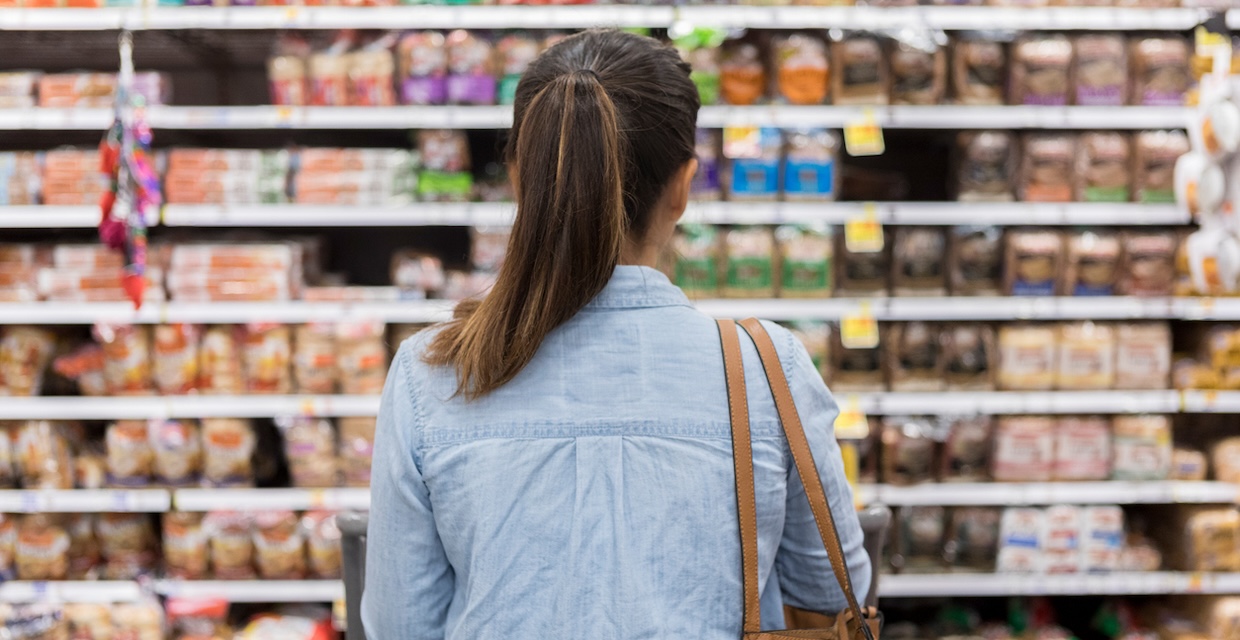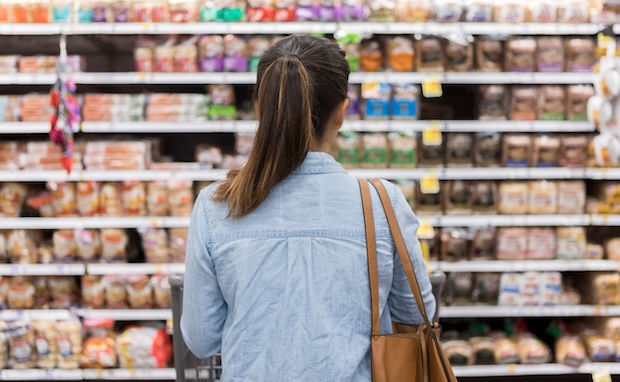Key Points:
- Ultra-processed foods (UPFs) are industrial formulations, often identified by ingredients rarely or never found in a home kitchen, such as emulsifiers, protein isolates, and artificial sweeteners.
- Research strongly links high UPF intake to an increased risk of all-cause mortality, Type 2 diabetes, cardiovascular disease, obesity, and common mental health disorders like anxiety and depression.
- Minimizing UPFs does not mean removing all UPFs completely. Replacing the worst offenders and relying on minimally processed, convenient options like canned beans and plain frozen vegetables can still have great health benefits while remaining realistic.
Ultra-processed foods (UPFs) are a hot topic right now.
Maybe you've heard that most of the food in your pantry falls into this category, or perhaps you're wondering how a simple whole-grain bread loaf could be in the same group as a sugary soda. The lines can feel blurry, making it confusing to know what to buy and what to leave on the shelf.
What exactly is an ultra-processed food? More importantly, how can you tell the difference between a simple ingredient and a cleverly disguised food science project?
We’ll break down how to identify these products with a simple, three-step method. We’ll also look beyond the obvious ingredients to explore the cutting-edge science that explains why ultra-processed foods actively drive weight gain and adverse health outcomes.
What are ultra-processed foods?
In the world of nutrition, food scientists use the NOVA classification system to group foods according to the extent and purpose of industrial processing. This system places all food into one of four distinct groups.
The NOVA system groups foods by the extent and purpose of industrial processing, ranging from minimally processed to ultra-processed foods.
Understanding the first three groups helps clarify what makes the fourth group – ultra-processed – so different.
The NOVA classification system
- NOVA Group 1 (unprocessed or minimally processed foods): These are whole foods in their natural state or those with minimal alterations like removing inedible parts, cutting, crushing, refrigeration, or freezing. Examples include fresh or frozen fruits and vegetables, eggs, meats, milk, and whole grains.
- NOVA Group 2 (processed culinary ingredients): These are substances derived from Group 1 foods that are used to season and cook meals. Examples include vegetable oils, butter, sugar, salt, and maple syrup.
- NOVA Group 3 (processed foods): These are relatively simple products made by combining foods from Groups 1 and 2, designed to increase durability or improve palatability. Examples include canned vegetables, simple cheeses, and bread made only from flour, water, yeast, and salt.
- NOVA Group 4 (ultra-processed foods - UPFs): These are industrial formulations that are typically ready-to-eat or ready-to-heat. They are generally made mostly or entirely from substances extracted from foods (like fats, starches, or protein isolates) and contain additives used to imitate sensory qualities or disguise undesirable ones.
This last group is the most concerning. They are designed to be extremely profitable, convenient, and, most importantly, hyper-palatable – making you want to eat more than you need.
The simple 3-step guide to spotting ultra-processed foods
You don't need a science degree to spot a UPF in the grocery aisle. You just need to know what to look for on the ingredient list.
“I help clients build awareness around ultra-processed foods by reviewing ingredient labels together and discussing what’s realistic for their lifestyle,” says Melinda Piatek, RD. “I point out cues like long ingredient lists or additives such as flavorings and stabilizers, while also acknowledging that convenience foods can be an important part of eating well. It’s less about labeling foods as ‘good’ or ‘bad’ and more about understanding where they fit in overall patterns and their impact on each individual's health needs.”
Step 1: Look for the ‘industrial ingredients’
Ultra-processed foods rely on substances that are extracted from whole foods and then chemically modified to be used as low-cost raw material.
If you see these ingredients in the top half of the ingredient list, it’s a sign that the product is an industrial formulation, not a simple food.
The primary components of UPFs are industrially sourced ingredients, which are derived from whole foods but often chemically modified, such as high-fructose corn syrup, protein isolates, and hydrogenated oils.
Key ingredients to look for:
- Modified sugars & syrups: High-fructose corn syrup, dextrose, maltodextrin, inverted sugar.
- Modified fats: Hydrogenated oils, interesterified oils.
- Protein isolates: Soy protein isolate, whey protein isolate, hydrolyzed proteins, gluten.
Step 2: Spot the ‘cosmetic additives’
Beyond the main filler ingredients, UPFs rely on "cosmetic" additives to make them look, feel, and taste appealing – often disguising the fact that they contain little whole food.
These are chemical compounds used solely to enhance the final product’s flavor, texture, and shelf life.
- Emulsifiers, stabilizers, and thickeners: Soy lecithin, carrageenan, xanthan gum, guar gum, mono- and diglycerides.
- Artificial sweeteners: Sucralose, aspartame, acesulfame-K, saccharin.
- Flavor enhancers: Yeast extract, monosodium glutamate (MSG), and "natural flavorings" that are chemically complex.
- Colors and dyes: Tartrazine (Yellow 5), Allura Red (Red 40).
Step 3: Check the ingredient list length
When you bake a batch of homemade cookies, your ingredient list is probably short: flour, butter, sugar, eggs, leavening, and vanilla extract. An industrial cookie has all of those, plus the additives to make it smooth, keep it from going stale, and ensure the flavors remain uniform for months.
This leads to a longer, more detailed ingredient list – a key red flag.
A good rule of thumb: if the product has five or more ingredients, take a closer look at what those ingredients are. If you see multiple items you wouldn't keep in your kitchen or that sound like a chemistry experiment, you’ve likely found a UPF.
How ultra-processed foods drive overeating
It’s easy to assume UPFs are bad simply because they are high in sugar, fat, and salt. However, cutting-edge science suggests that the processing itself – the way the food is physically engineered – is a primary cause of poor health outcomes.
The single most influential study demonstrating this tested two diets: they were equal in sugar, fat, sodium, fiber, and macronutrients, but one contained a majority UPFs while the other focused on whole foods.
When study participants switched to a diet based on ultra-processed foods, they naturally ate an average of 500 extra calories per day and gained weight over a two-week period. This suggests UPFs cause overconsumption, regardless of their basic nutritional label.
UPFs are too easy to eat
Why did people eat 500 extra calories when all the nutrients were the same? The answer lies in the food's physical structure.
UPFs are deliberately soft, easy to chew, and require less digestive effort. The soft texture allows us to eat them very quickly.
This is one reason why experts often refer to these foods as "predigested," meaning your body does less work to consume them. The same food is consumed more quickly, bypassing the body's natural satiety signals and leading to higher overall calorie intake.
The gut-health connection
Another emerging area of concern is how the "cosmetic additives" affect our digestive system. While approved for use, these additives may interfere with the gut.
Two common emulsifiers (carboxymethylcellulose and polysorbate 80) were found to disrupt the intestinal barrier function in mice, modulating the gut microbiota. This may increase inflammation and could contribute to conditions like metabolic syndrome.
Other research suggest that these additives, which include gums and thickeners, may play a role in promoting intestinal inflammation and affecting our metabolisms.
The health risk of UPFs: more than just obesity
The link between a diet heavy in UPFs and negative health outcomes is not merely anecdotal; it is supported by vast amounts of data involving millions of participants.
A higher risk of chronic disease
Diets high in ultra-processed foods have been consistently linked to weight gain, chronic disease, and poor mental health outcomes.
The strongest available evidence supports a direct link between greater UPF consumption and a higher risk of diseases like type 2 diabetes, obesity, and depressive outcomes, as shown by a comprehensive umbrella review of meta-analyses.
This analysis found strong links across 32 different health parameters across mortality, cancer, mental, respiratory, cardiovascular, gastrointestinal, and metabolic health outcomes.
Differentiating among UPFs: which are okay to eat?
The goal of identifying ultra-processed foods is not to create a stressful, all-or-nothing approach to eating. Demonizing any particular food usually backfires and leads to more food anxiety.
It’s easy to feel overwhelmed when the NOVA classification system labels something like simple yogurt or whole-grain bread as a UPF because it contains an emulsifier or a non-traditional ingredient.
The NOVA classification system itself has received criticism for its binary nature, which groups foods with vastly different nutritional values together, such as a sugar-sweetened beverage and a fortified whole-grain cereal.
Focusing on minimizing the worst offenders and choosing convenient, nutrient-dense options when needed is usually the most practical approach.
Not all processed foods are equal (NOVA Group 3 vs. Group 4)
Remember, processed is not the same as ultra-processed.
The goal is not to eliminate all convenience foods – just to choose better processed options. You should feel confident using foods from NOVA Group 3:
- Canned beans and legumes: These are a huge time-saver but still offer fiber and protein.
- Frozen fruits and vegetables (plain): Often picked at peak ripeness and flash-frozen, frozen produce can even contain more nutrients than "fresh" produce that has traveled long distances. Just be sure to select options without added sauces or flavoring.
- Plain yogurt and simple cheeses: These are excellent sources of protein and calcium.
These options help you put a healthy meal on the table faster while still giving your body the nutrients it needs.
UPFs to reduce
If 80% of American calories come from UPFs, you can’t cut them all out overnight.
Start by prioritizing the UPFs that are consistently linked to the poorest outcomes:
- Sugary drinks: Sodas, fruit drinks, and energy drinks
- Sweet and salty packaged snacks: Chips, candy, mass-produced cakes, and cookies
- Meat products: Hot dogs, chicken nuggets, and certain lunch meats (often high in fat, sodium, and additives)
If you can replace these three categories with whole foods – or even less-processed alternatives – you will see the greatest positive change.
Practical steps for healthier groceries
The shift away from ultra-processed foods is ultimately a shift back toward eating food that is closer to its source. It’s about being an ingredient detective.
“I recommend small, realistic swaps that fit each client’s lifestyle, like choosing a higher-protein plain yogurt and adding fresh or frozen fruit instead of flavored varieties, making a quick homemade version of a favorite store-bought snack, or picking a pre-packaged item with nourishing ingredients and balanced nutrients,” says Melinda Piatek, RD.
“The goal isn’t perfection but progress, finding a balance that supports health, energy, and enjoyment. It’s not about cooking everything from scratch or avoiding convenience, but making gradual, sustainable changes that fit with each person’s needs.”
Here are a few actionable steps you can start taking today:
- Become an ingredient detective: Never shop based on the marketing claims on the front of the box. Flip it over and read the ingredients list first. Look for those "industrial" and "cosmetic" red flags.
- Prioritize fiber and protein: Ensure your meals are anchored by a source of fiber (vegetables, whole grains, beans) and lean protein (eggs, poultry, fish, tofu). Protein and fiber promote satiety, making you less likely to reach for a hyper-palatable snack later.
- Shop the perimeter: Grocery stores are typically designed with whole foods (produce, meat, dairy) around the outside perimeter and highly processed foods in the central aisles. Spend 80% of your shopping time along the outside walls.
- Cook by recipe: The food industry wants to do all the cooking for you. Simply cooking meals at home more often gives you full control over the ingredients, allowing you to sidestep most ultra-processing naturally. Selecting a cookbook to cook from can be a fun and easy way to do this, removing the mental burden of putting together a meal but empowering you to create your own healthy meals.
Final Thoughts
When it comes to reducing ultra-processed foods, remember the three core insights:
- Read the label: If an ingredient is unfamiliar or sounds industrial (e.g., gums, isolates, hydrogenated oils), it's a UPF.
- The processing matters: UPFs are engineered to be eaten so fast that they bypass your body’s natural satiety signals, causing you to overeat. Eat your food slowly, regardless of the source, and take time to savor it. Be patient before reaching for another serving, allowing your body time to process what you’ve already eaten.
- Aim for realistic change: Focus on replacing the sugary drinks and empty snacks with minimally processed, nutrient-dense alternatives.
You don't need to eliminate every processed food, but reducing the most hyper-palatable offenders is one of the most powerful steps you can take for your long-term health.
A registered dietitian (RD) can help you create a personalized plan to reduce UPFs without sacrificing convenience. They can guide you in making sustainable changes that honor your budget and busy schedule. Get started now.
Frequently Asked Questions (FAQs)
Are all processed foods bad for you?
No. Many processed foods are convenient and beneficial. Foods like canned beans, plain frozen vegetables, pasteurized milk, and whole-grain pasta fall into the minimally processed or processed categories and provide essential nutrients like fiber, vitamins, and protein. Health recommendations focus on limiting ultra-processed foods that are high in added sugar, salt, and fat.
What are some common examples of ultra-processed foods?
Common examples include carbonated soft drinks, packaged salty or sweet snacks (chips, cookies, cakes), reconstituted meat products (hot dogs, chicken nuggets), frozen meals, instant soups, and mass-produced breakfast cereals. The key indicator is the use of industrial ingredients and cosmetic additives.
Is bread ultra-processed?
It depends on the ingredients. Minimally processed bread (NOVA Group 3) made traditionally with only flour, yeast, salt, and water is considered a processed food. Ultra-processed bread (NOVA Group 4), which includes the majority of mass-produced, sliced sandwich loaves, will contain added ingredients like high-fructose corn syrup, protein isolates, emulsifiers (like DATEM or monoglycerides), and chemical preservatives to extend shelf life and create a soft, spongy texture.
The views expressed by authors and contributors of such content are not endorsed or approved by Fay and are intended for informational purposes only. The content is reviewed by Fay only to confirm educational value and audience interest. You are encouraged to discuss any questions that you may have about your health with a healthcare provider.
Sources
Fay Nutrition has strict sourcing guidelines and relies on peer-reviewed studies, academic research institutions, and medical associations. We avoid using tertiary references.
- Dietary emulsifiers promote both colitis and metabolic syndrome in mice - Nature
- Ultra-processed diets cause excess calorie intake and weight gain: An inpatient randomized controlled trial of ad libitum food intake - Cell Metabolism
- Ultra-processed food exposure and adverse health outcomes: umbrella review of epidemiological meta-analyses - BMJ
- Ultra-processed foods: how functional is the NOVA system? - European Journal of Clinical Nutrition
- Using the Nova classification system to identify and estimate intake of ultraprocessed foods - American Society for Nutrition
- Food Additives - The Nutrition Source (Harvard Health)
- Food Additives Associated with Gut Microbiota Alterations in Inflammatory Bowel Disease: Friends or Enemies? - MDPI Nutrients











